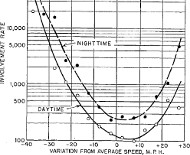11/10/2017
Government Study In 1964 Revealed Dangerously Slow DriversReport from precursor to US Department of Transportation found driving slower than the flow of traffic is dangerous.

Half a century ago, US government officials were concerned enough about the safety of rural highways to take a closer look at the causes of accidents. In an exhaustive survey, the Commerce Department's Bureau of Public Roads -- which has since become the Transportation Department's Federal Highway Administration -- concluded that excessively slow driving is every bit as dangerous as overly fast driving.
The agency's chief researcher, David Solomon, compiled the results of a massive eleven-state study that covered 600 miles of main rural highways, accidents involving 10,000 drivers and interviews with 290,000 motorists. The road segments had traffic of up to 24,000 vehicles per day and speed limits of between 55 and 70 MPH. After crunching the numbers, Solomon found that the simplistic slogan "slow down" was not the key to improving highway safety, and that such slogans are actually counterproductive.
"Within the limits of the study, there is an unmistakable indication that low-speed drivers are more likely to be involved in accidents than relatively high-speed drivers," the report concluded. "Note that at extremely high speeds, approaching 80 mile an hour, the difference would disappear."
It is common to see traffic on many interstate highways cruising above the posted speed limit. When a car in the left lane, however, decides to stick to the lower speed, it creates a backup. Cars then accelerate much faster than traffic on the right to get past the bunched up traffic, creating greater risk. Such individual observations fit within the statistically significant findings that resulted in the chart now known as Solomon's curve.
"It is clear that regardless of the average speed on a main rural highway, the greater the driver's variation from this average speed, the greater his chance of being involved in an accident," the report explained. "The lowest [accident] involvement rate occurred at the average speed or slightly above it. As speeds departed from the average speed in either direction, the involvement rate increased in a nearly symmetrical fashion."
The consequences of a high-speed accident, however, were found to be more severe, with injury rates soaring at speeds exceeding 70 MPH. Yet the report even found that inherently slower automobiles also proved to be less safe, on average, than fast cars.
"Drivers of passenger cars having low horsepower had higher involvement rates than drivers of cars having higher horsepower, regardless of the other variables studied," the report found. "This may he related to the relatively poor acceleration capability at highway speeds of cars having low horsepower."
The Solomon report's findings are at odds with those produced by the Insurance Institute for Highway Safety (IIHS), an organization funded by the insurance industry. That industry earns additional revenue from every speeding ticket issued through surcharges. The industry has produced research slamming the Solomon Report, but IIHS researchers have had their own academic integrity questioned.
A copy of the 1964 study is available in a 3.5mb PDF file at the source link below.


